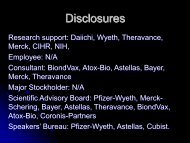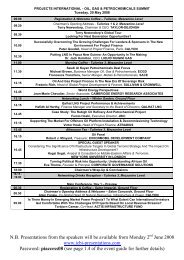Roger Finch.pdf
Roger Finch.pdf
Roger Finch.pdf
- No tags were found...
You also want an ePaper? Increase the reach of your titles
YUMPU automatically turns print PDFs into web optimized ePapers that Google loves.
BSAC: Celebrating 40 years of achievementSo what is the future?Professor <strong>Roger</strong> G <strong>Finch</strong>Nottingham University Hospitals &Nottingham University Hospitals &University of Nottingham, UK
JAC – 1975 & 2011MARCH 1975 (11) MARCH 2011 (32)Editorials – 4 JD Williams; LP Garrod; Editorials – fewerHP Lambert; R WiseReviews - inhibitors of influenza virus- R factors in EnterobacteriaceaeReviews – role of polyenesOriginal articles• clinical•PK• ADR/safety• resistance mechanisms• new agents (cefamandole)• gentamicin assays( ) = total number of articlesOriginal articles• resistance (21)• new agents (2): small molecules;cupuramycins• HIV (5); HCV (2)• mycology (2)• parasitology (3)•clinical i l studies
Decline in the licensing of new antibioticsterial AgentsTotal # New Antibac181614121086420*R 2 = 0.99*R 2 =0990.991983-87 1988-92 1993-97 1998-2002 2003-07 2008-present*p = 0.007 by linear regressionNew antibacterial agent≡ new molecular entity (NME) with antimicrobial properties,administered for systemic infection; topical agents and immunomodulators excludedIDSA 2003 – updated March 2011
The Future- pipeline antibacterials (phase III)Drug Class CommentsTelavancin Glycopeptide cSSTI, HAPOritavancin Glycopeptide cSSTINOTE – no newDalbavancin Glycopeptide cSSTI, catheter associatedbacteraemiaagents for MDRIclaprim Antifolate AbandonedGram-negativesCeftobiprole Cephalosporin On holdCeftaroline Cephalosporin Approved by FDAFaropenem Penem Rejected by FDAFidaxomicin Macrocyclic RNA inhibitor Trials completed for CDILactoferrin Peptide Childhood diarrhoeaReport prepared for ARHAI (HPA-AMRL) 2010
Development of new classesof antibacterial agents1962: Quinolones1962: Streptogramins1958: Glycopeptides1952: Macrolides1950: Aminoglycosides1949: Chloramphenicol1949: Tetracyclines1940: β-lactamsl t1936: Sulfonamides2003: Lipopeptidesp p1999: Oxazolidinones1930 1940 1950 1960 1970 1980 1990 2000 2010Norrby SR, et al. Lancet Infectious Diseases 2005; 5:115–9.
Licensed indications of recentlymarketed antibacterialst i Drug FDA approved IndicationsLinezolid 2000 CAP, cSSTI, HAP (including MRSA/MDRSP), VREErtapenem 2001 CAP, cSSTI (+ diabetic foot), cIAS, acute pelvicinfectionsGemifloxacin 2003 Acute sinusitisDaptomycin 2003 cSSTI, Staph bacteraemia, right heart staphendocarditis‘Helpful but – a still aTigecycline 2006 CAP, cSSTI, cIASDoripenem 2007 cIAS, cUTICeftobiprole 2009 cSSTI (diabetic foot)Telavancin 2009 cSSTIsignificant mismatchbetween what is neededand what is licensed’-Indications often drivenby what can beapprovedCAP = community acquired pneumoniac = complicated IAS = intraabdominal sepsisSSTI = skin and skin structure infections MRSA/MSSA = methicillin resistant/sensitive Staph aureusHAP = hospital acquired pneumonia MDRSP = multi-drug resistant Strep. pneumoniaeVRE= Vancomycin resistant enterococciUTI= urinary tract infection
Streptococcus pneumoniae infections(USA)‘Can create similar‘pyramids’ for eachorganism includingdrug resistantpathogens’
What better therapies do we need?- the challenge of MRSACurrent best therapy…still not good enoughStaph. aureus BSI -mortality ratesMRSA 34.2%MSSA 19.6%Much choice but whatevidence is there thatwe have more effectivetreatmentShurland et al Inf Cont Hosp Epid 2007AND… new drugshave mostlydemonstratedt dequivalence/noninferiorioritytovancomycin
What pathogens/diseasesrequire new therapies? MDRGNB MDR/XDR-TB• ESBL producers• carbapenemase producers• efflux resistance Diarrhoeal/enteric pathogens Additional effective decolonisation agents Hepatitis viruses, influenza, RSV, HIV
Conclusion – the future‘… is aboutliving with theever increasingchallenge ofdrug resistantinfections’
Strategic control of antibioticresistance – national/internationalt l(House of Lords Report, WHO,IDSA,EU etc…..)better microbiological surveillancemonitor antibiotic usageStill largelyaspirationalrather thana realitypromote infection control and hygieneeducate professionals & the publicpromote prudent prescribing/reduceunnecessary useencourage new technologies
Strategic control of antibioticresistance – the specific needsRobust real time local microbiological surveillance (community aswell as hospital) that informs national/international databases Antibiotic usage – ascribed real time trends in hospital andcommunity prescribing Infection control and hygiene – make patient safety the priority –sound procedures and zero tolerance Patient to unsafe safety practices Universal antimicrobial stewardship must programmesbe the Effective international regulation that supports new drugdevelopmentlead qualityIncentivise a repertoire of integrated standardtechnologies to supportthese strategic goals
Key technology needs tosupport these strategic goals New medicines Vaccines to control drug resistantinfections as well as diseases Electronic surveillance of infections andresistance trendsto deliver safe Electronic monitoring of and drug effective usagecare!’ Electronic prescribing support Rapid/near patient diagnostics‘The right ‘tools’
Future scenario ‐ antibacterials‘Blockbuster’ drugs are now essentially historicalTargeted treatments are increasingly requiredThe h focus should ldbe on quality and not on quantity –novelty rather than ‘me‐too’More robust definitions of endpoints including duration oftreatment are key to clinical use and patient safety andgreater efficiency in drug developmentBUT – a repertoire of new agents is needed@ $1billion + 10 years to develop eachBSAC –The Urgent Need
The EducationalChallengeUK NHS Staff (2005)Doctors: 120,000Nurses: 400,000Dentists: 20,000Electronicprescribing support
On-line prescribing Links diagnosis with recommended treatment Avoids dosage errors Avoids drug interactionsMaking Connects with electronic patient prescribingrecords Links laboratory data and treatment safer selectionand Educationalmore cost- Data readily audited to improve practiceeffective
Antimicrobial Stewardship Programmes Increasingly adopted across healthcare Drive guidance, implementation and auditof prescribingThe evidence is Becoming a performance only as good and as the qualitystandard science – a need forgreater commitment Risk of driving genericto developingprescribingtheandhomogenising national evidencepractice Must be linked to outcomes based data toreally improve current practice
RapidDiagnostics‘Taking theguesswork outof prescribing’
The advantages of better andfaster diagnostics Supports clinical diagnosis Confirms microbiological nature of infection Supports appropriate selection ‘Goal of – therapies to use Distinguishes antibiotic responsive what we have from nonresponsiveillness better, reduce the Reduces risk of adverse drugriskreactionsof resistancefromand prolong theinappropriate therapyeffective life of Reduces risks of antibiotic resistance drugs’ Improves cost effectiveness of prescribing
AdvantagesPOC/Rapid diagnostics anddrug developmentAdds precision to case definitionPotential ability to clarify microbiological end‐pointsReduce unevaluable infections/patientsReduce target numbers required for CTAbility to enrich studies by targeting drug resistantinfectionsContain i the costs of drug developmentBSAC –The Urgent Need
POC/Rapid diagnostics and drugDisadvantagesdevelopmentNovel diagnostics will need to be developed andindependently validatedPharma and Diagnostic companies are currently mostlyseparate entitiesInclusion of a novel diagnostic may limit external validity offindings in clinical practice in different healthcare settingsthereby frustrating marketingCurrent variability in performance and unsatisfactorystandards of licensing and regulation of diagnostics will needto be addressedBSAC –The Urgent Need
Incentives to encourage newdrug development Prioritise AI research including strongsustainable partnerships with academia Licensing i & Regulation - make internationalti harmonisation of guidance a reality and notjust an aspiration Create a more equitable healthcare market– antiinfectives v anticancer– generics that are time expired– patent protective and supportive ofhigh quality medicines globally
The Way Forward Pharma & biotech – new antibiotics will always berequired – the need is now Diagnostics Industry– the need is great and themarket wide open; create partnerships with Pharma Healthcare – define and articulate your technologyneeds; recognise their true economic value; beprepared to pay more Licensing – encourage innovation; ensure licensingbetter supports clinical need; review approvedindications of generics to match clinical practice Governments – think globally; think strategically;build sustainable alliances; develop joined uppolicies; establish champions
The future is challenging, theproblems global but a matrixof solutions is both possibleand achievablethe future is bright… the future is brightTHE FUTURE IS YOURS








